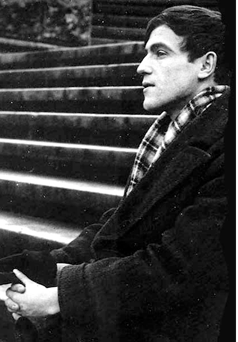
Richard Grune
(August 2, 1903 - November 26, 1984)
The artist Richard Grune was twenty-nine years old when he moved to Berlin to find a place for himself in the city’s world-famous LGBTQ+ community. Unfortunately, Adolf Hitler was appointed chancellor at the same time. The Nazis arrested Grune for being gay and he spent a decade locked away in prisons and concentration camps.
*****
This page tells the story of one individual. Read this introductory essay for an overview of the history of the Nazis' persecution of LGBTQ+ people.
*****
Lee la historia de Richard Grune en español.
Read Richard Grune's story in Spanish.
This essay was written by Pink Triangle Legacies Project Founder Dr. Jake Newsome and is based on the important research of Andreas Sternweiler, Dr. Elizabeth Otto, and the staff at the Flossenbürg Concentration Camp Memorial. It was translated into Spanish by Amilcar Ferrero. Thank you for your work in preserving queer history.
Richard Grune was born in Flensburg, a small coastal town in northern Germany. His parents supported his interest in art and sent him to an art college in nearby Kiel. At 19, Richard studied for a year at the renowned Bauhaus art and design school. He premiered his first solo exhibition in Kiel in 1926.
Richard found it impossible to live openly as a gay man in the conservative town of his childhood, so in February 1933, he moved to Berlin (Germany’s capital) to find a place for himself in the city’s famous LGBTQ+ culture.
Unfortunately, Adolf Hitler had been named Chancellor of Germany only weeks before Richard’s arrival. Richard’s parents were Social Democrats and they had taught him the ideals of individual liberty. These ideals, in combination with the Nazis’ increasingly homophobic messages, probably influenced Richard’s stance against the Nazi government. Richard began contributing his artistic efforts to a series of anti-fascist pamphlets.

Schwules Museum

Schwules Museum

KZ-Gedenkstätte Neuengamme, c/o US Holocaust Memorial Museum

Schwules Museum
The Nazis had already begun closing down LGBTQ+ meeting places in Berlin, so LGBTQ+ people had to meet each other in private. Because Richard had his own apartment, he hosted a couple of parties for his gay friends in fall 1934. During the parties, one of the attendees – Princess Inge Ellen zu Bentheim – made note of the names, professions, and addresses of the men in attendance. In November, she turned in a long list of gay men to the Nazis.
Between December 1-5, 1934, the Gestapo arrested Richard and 70 other men who had attended his parties. Richard was put in “protective custody” in a jail for 5 months without trial. Eventually, a judge sentenced Richard to 15 months in prison under Paragraph 175, Germany’s law that criminalized “unnatural indecency between men.”
As soon as the police released him from prison at the end of his term, the Gestapo put Richard back in “protective custody,” arguing his sentence had been too lenient for someone who had thrown parties that “seduced” so many men into “indecency.” In October 1937, the Nazis sent Richard to Sachsenhausen concentration camp. He was transferred to Flossenbürg concentration camp in April 1940, where he stayed until he escaped during liberation in April 1945. In total, Richard survived nearly 10 years in prison and concentration camps.
“After I was liberated in 1945, I saw it as my duty to educate people about the concentration camps and the terror of the Third Reich,” Richard said. He sought to do this by creating nearly 40 drawings, which he curated into a traveling exhibit called “The Pariahs” that premiered in Nuremberg in 1945, at the same time as the international war crime trials against former Nazi leaders. Unfortunately, much of the German public was averse to confronting Nazi crimes in detail. Furthermore, social and institutional homophobia was still widespread, and the Allies had kept the Nazi version of Paragraph 175 in their zones of occupation, which meant that homosexuality was still illegal. Richard persisted and published his artwork into a portfolio in 1947. His exhibit and portfolio were the first visual works on this topic to be made available to the public.
Richard tried to gain official recognition as a victim of Nazism, which would have made him eligible for legal and financial aid in rebuilding his life. But the authorities rejected his claims since he had been imprisoned for being gay. Richard was arrested under Paragraph 175 again in 1948. When he was released, he moved to Barcelona, hoping to find a more accepting place to live. After almost fifteen years, financial hardship forced him to return to Germany in 1962. He died in Kiel in a retirement home in November 1984.
Sources & Further Reading
Flossenbürg Concentration Camp Memorial and the Foundation of Bavarian Memorials, “Live On,” online exhibit (2021)
Flossenbürg Concentration Camp Memorial, “Richard Grune – Bearing Witness,” YouTube Video (April 15, 2021)
Andreas Sternweiler, “‘... er habe sich zeichnend am Leben erhalten’ Der Künstler Richard Grune,” in Joachim Müller and Andreas Sternweiler, Homosexuelle Männer im KZ Sachsenhausen. Berlin, 2000, pg 190-206.
Elizabeth Otto, “Queer Bauhaus,” chapter in Haunted Bauhaus: Occult Spirituality, Gender Fluidity, Queer Identities, and Radical Politics. MIT Press, 2019.
Elizabeth Otto, “Queer People Have to Some Extent Been Erased from Bauhaus History,” interview for bauhaus kooperation.
For Citation
Jake Newsome, "LGBTQ+ Stories from Nazi Germany: Richard Grune." (2024) pinktrianglelegacies.org/grune
(Updated January 2024)
